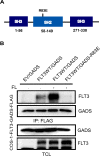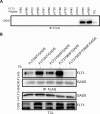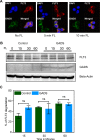Expression of GADS enhances FLT3-induced mitogenic signaling
- PMID: 26895103
- PMCID: PMC4924701
- DOI: 10.18632/oncotarget.7415
Expression of GADS enhances FLT3-induced mitogenic signaling
Abstract
GADS is a member of a family of SH2 and SH3 domain-containing adaptors that functions in tyrosine kinase-mediated signaling cascades. Its expression is largely restricted to hematopoietic tissues and cell lines. Therefore, GADS is mainly involved in leukocyte-specific protein tyrosine kinase signaling. GADS is known to interact with tyrosine-phosphorylated SHC, BCR-ABL and KIT. The SH2 domain of GADS has a similar binding specificity to that of GRB2 but its SH3 domain displays a different binding specificity, and thus it is involved in other downstream signaling pathways than GRB2. In the present study, we examined the role of GADS in FLT3 signaling. FLT3 is a type III receptor tyrosine kinase, which is mutated in more than 30% of acute myeloid leukemia (AML) and the most common mutations is the internal tandem duplication (ITD) mutations. We observed that expression of GADS enhanced oncogenic FLT3-ITD-induced cell proliferation and colony formation in vitro. In a mouse xenograft model, GADS accelerated FLT3-ITD-dependent tumor formation. Furthermore, expression of GADS induced a transcriptional program leading to upregulation of MYC and mTORC1 target genes. GADS localizes to the cell membrane and strongly binds to ligand-stimulated wild-type FLT3 or is constitutively associated with the oncogenic mutant FLT3-ITD. We mapped the binding sites in FLT3 to pY955 and pY969 which overlaps with the GRB2 binding sites. Expression of GADS enhanced FLT3-mediated phosphorylation of AKT, ERK1/2, p38 and STAT5. Taken together, our data suggests that GADS is an important downstream component of FLT3 signaling and expression of GADS potentiates FLT3-mediated mitogenic signaling.
Keywords: AML; FLT3-ITD; GRAP2; RTK; STAT5.
Conflict of interest statement
The authors declare no conflicts of interest.
Figures









Similar articles
-
FYN expression potentiates FLT3-ITD induced STAT5 signaling in acute myeloid leukemia.Oncotarget. 2016 Mar 1;7(9):9964-74. doi: 10.18632/oncotarget.7128. Oncotarget. 2016. PMID: 26848862 Free PMC article.
-
Src-like adaptor protein 2 (SLAP2) binds to and inhibits FLT3 signaling.Oncotarget. 2016 Sep 6;7(36):57770-57782. doi: 10.18632/oncotarget.10760. Oncotarget. 2016. PMID: 27458164 Free PMC article.
-
Oncogenic FLT3-ITD supports autophagy via ATF4 in acute myeloid leukemia.Oncogene. 2018 Feb 8;37(6):787-797. doi: 10.1038/onc.2017.376. Epub 2017 Oct 23. Oncogene. 2018. PMID: 29059168 Free PMC article.
-
Expression of FLT3 receptor and response to FLT3 ligand by leukemic cells.Leukemia. 1996 Apr;10(4):588-99. Leukemia. 1996. PMID: 8618433 Review.
-
Bridging the Gap: Modulatory Roles of the Grb2-Family Adaptor, Gads, in Cellular and Allergic Immune Responses.Front Immunol. 2019 Jul 25;10:1704. doi: 10.3389/fimmu.2019.01704. eCollection 2019. Front Immunol. 2019. PMID: 31402911 Free PMC article. Review.
Cited by
-
PRMT1-mediated FLT3 arginine methylation promotes maintenance of FLT3-ITD+ acute myeloid leukemia.Blood. 2019 Aug 8;134(6):548-560. doi: 10.1182/blood.2019001282. Epub 2019 Jun 19. Blood. 2019. PMID: 31217189 Free PMC article.
-
The Src family kinase LCK cooperates with oncogenic FLT3/ITD in cellular transformation.Sci Rep. 2017 Oct 23;7(1):13734. doi: 10.1038/s41598-017-14033-4. Sci Rep. 2017. PMID: 29062038 Free PMC article.
-
Targeting PRMT1-mediated FLT3 methylation disrupts maintenance of MLL-rearranged acute lymphoblastic leukemia.Blood. 2019 Oct 10;134(15):1257-1268. doi: 10.1182/blood.2019002457. Blood. 2019. PMID: 31395602 Free PMC article.
-
Glucocorticoid-resistant B cell acute lymphoblastic leukemia displays receptor tyrosine kinase activation.NPJ Genom Med. 2019 Apr 4;4:7. doi: 10.1038/s41525-019-0082-y. eCollection 2019. NPJ Genom Med. 2019. PMID: 30962949 Free PMC article.
-
Atractylenolide-1 Targets FLT3 to Regulate PI3K/AKT/HIF1-α Pathway to Inhibit Osteogenic Differentiation of Human Valve Interstitial Cells.Front Pharmacol. 2022 Apr 25;13:899775. doi: 10.3389/fphar.2022.899775. eCollection 2022. Front Pharmacol. 2022. PMID: 35571096 Free PMC article.
References
-
- Kabir NN, Rönnstrand L, Kazi JU. FLT3 mutations in patients with childhood acute lymphoblastic leukemia (ALL) Med Oncol. 2013;30:462. - PubMed
-
- Masson K, Rönnstrand L. Oncogenic signaling from the hematopoietic growth factor receptors c-Kit and Flt3. Cell Signal. 2009;21:1717–1726. - PubMed
-
- Lyman SD, James L, Vanden Bos T, de Vries P, Brasel K, Gliniak B, Hollingsworth LT, Picha KS, McKenna HJ, Splett RR, et al. Molecular cloning of a ligand for the flt3/flk-2 tyrosine kinase receptor: a proliferative factor for primitive hematopoietic cells. Cell. 1993;75:1157–1167. - PubMed
-
- Lyman SD, James L, Johnson L, Brasel K, de Vries P, Escobar SS, Downey H, Splett RR, Beckmann MP, McKenna HJ. Cloning of the human homologue of the murine flt3 ligand: a growth factor for early hematopoietic progenitor cells. Blood. 1994;83:2795–2801. - PubMed
-
- Hannum C, Culpepper J, Campbell D, McClanahan T, Zurawski S, Bazan JF, Kastelein R, Hudak S, Wagner J, Mattson J, et al. Ligand for FLT3/FLK2 receptor tyrosine kinase regulates growth of haematopoietic stem cells and is encoded by variant RNAs. Nature. 1994;368:643–648. - PubMed
MeSH terms
Substances
LinkOut - more resources
Full Text Sources
Other Literature Sources
Molecular Biology Databases
Research Materials
Miscellaneous

